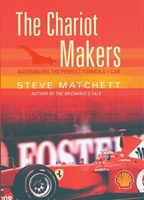“The power output of an engine [equals] the size of the bangs, times the number of bangs per minute that you can manage to get.”
Keith Duckworth — Cosworth Engineering
Former Benetton mechanic Steve Matchett has written a new book, The Chariot Makers: Assembling the Perfect Formula 1 Car. True to his usual style, it is a breezy, informal, and very readable book. While perhaps too light on detail to satisfy the most hardcore mechanic, it’s aimed at those of us who merely appreciate the engineering that goes into race cars, rather than understand it.
Before his second careers as an author, commentator and announcer for Speedvision, Steve Matchett was perhaps best known for being one of the Benetton mechanics who caught fire at the German Grand Prix in 1994 (you should really watch the video for the full effect — it’s quite stunning that no one was killed.)
In The Chariot Makers, Matchett discusses his final trip to New York to work for Speedvision, around the tragic events of September 11th. Stuck in an Air France executive lounge with some wealthy and quite stereotyped British men (I half-expected to see “Pip! Pip! Cheerio, old boy!” whenever I turned a page), Steve and our public school lads pass the time by trying to build — on paper — the perfect Formula 1 car. In doing this, he takes us on a tour of the great leaps grand prix technology has made over the years (the first monocoque, the first carbon-fibre chassis, and so on) and also explains some of the tradeoffs that go in to building such a beast.
Matchett deliberately eschews the maths behind the mechanics, and goes directly for metaphor and example whenever possible. His written voice is, in fact, very much like the spoken voice he uses when commenting on races:
Blasting around the race track, a Formula 1 car sticks to the ground in exactly the same way that an aircraft doesn’t… When the amount of lift generated by [an aircraft's] wings exceeds the aircraft’s weight it will take-off. In the case of our Formula 1 car, the very last thing we want is for it to take-off. For, although this will certainly focus the driver’s attention, it also has the tendency to sap his confidence.
The Chariot Makers is about on par with Matchett’s earlier book The Mechanic’s Tale, which covered his experiences seeking (and getting) a job as a mechanic for a Grand Prix team. It’s far superior to his initial foray into writing, Life in the Fast Lane, a somewhat breathless and obsequious catalogue of Benetton’s 1994 season. Matchett is at his best when he is focusing on the technology and how it relates to the driver and the team. If he sometimes tries a little too hard to tell a story (“I say, Steve, old lad…”), we can forgive him because it’s so clear that he is completely in love with the subject matter.
My one serious complaint about the book is that it desperately needs a bibliography. I understand — and agree with — Matchett’s decision to not go into to excessive mechanical detail, but for those of us who wanted to delve further into the subject mattter, some pointer to other resources (other than “Get a job with an F1 team”) would have been valuable.
Pip pip, cheerio, Steve.
You can find The Chariot Makers at Amazon.com, or at your local bookstore.





